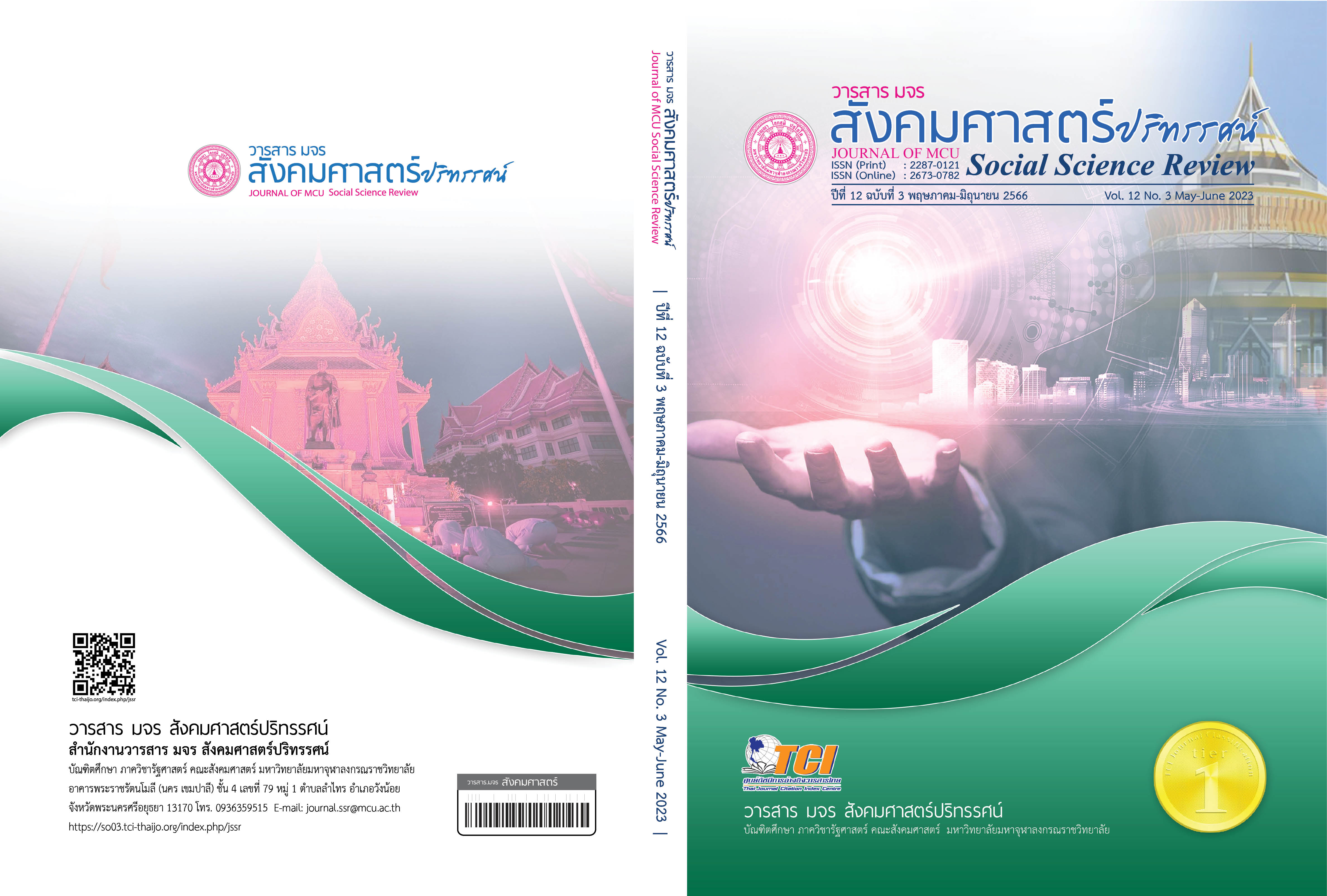การพัฒนาการท่องเที่ยวเชิงสร้างสรรค์ในอุทยานธรณีโลกสตูล
คำสำคัญ:
การพัฒนาการท่องเที่ยว, การท่องเที่ยวเชิงสร้างสรรค์, อุทยานธรณีโลกสตูลบทคัดย่อ
บทความวิจัยนี้มีวัตถุประสงค์ 1. เพื่อศึกษาทรัพยากรการท่องเที่ยวที่สามารถนำมาส่งเสริมศักยภาพเพื่อขับเคลื่อนกิจกรรมการท่องเที่ยวเชิงสร้างสรรค์ 2. เพื่อพัฒนากิจกรรมการท่องเที่ยวเชิงสร้างสรรค์ 3. เพื่อพัฒนาเส้นทางท่องเที่ยวเชิงสร้างสรรค์ 4. เพื่อเสนอแนวทางการจัดการการท่องเที่ยวเชิงสร้างสรรค์ ในพื้นที่อุทยานธรณีโลกสตูล ใช้การวิจัยแบบผสมผสานโดยการวิจัยเชิงคุณภาพเป็นหลัก และตรวจสอบผลด้วยการวิจัยเชิงปริมาณ
ผลการวิจัยพบว่า 1. ทรัพยากรที่ผ่านการประเมินและสามารถนำมาส่งเสริมศักยภาพเพื่อขับเคลื่อนกิจกรรมการท่องเที่ยวเชิงสร้างสรรค์ในอุทยานธรณีโลกสตูล แบ่งได้เป็น ทรัพยากรทางธรรมชาติ ทรัพยากรทางธรณี และทรัพยากรทางวัฒนธรรม รวมทั้งสิ้น 32 แห่ง 2. การพัฒนากิจกรรมการท่องเที่ยวเชิงสร้างสรรค์ เป็นการนำทรัพยากรทางธรรมชาติ ทางธรณี วิถีชีวิต และภูมิปัญญา มาสร้างให้เกิดกิจกรรมสำหรับนักท่องเที่ยวและสอดคล้องกับความเป็นอุทยานธรณีโลกสตูล 3. การพัฒนาเส้นทางการท่องเที่ยวเชิงสร้างสรรค์ ได้เส้นทางสำเร็จรูปทั้งสิ้น 4 เส้นทาง ครอบคลุมทุกพื้นที่ของอุทยานธรณีโลกสตูล 4. การเสนอแนวทางด้านการจัดการการท่องเที่ยวเชิงสร้างสรรค์ในอุทยานธรณีโลกสตูล ควรมีการบูรณาการจากทุกฝ่ายทั้งภาครัฐและภาคเอกชนที่มีส่วนเกี่ยวข้อง จัดเตรียมสิ่งอำนวยความสะดวกขั้นพื้นฐานและสาธารณูปโภคที่เหมาะสม โดยมุ่งเน้นการมีส่วนร่วมของคนในท้องถิ่น เพื่อเป็นฐานในการอนุรักษ์ทรัพยากรธรรมชาติ ตลอดจนวิถีชีวิต วัฒนธรรม ให้ดำรงอยู่อย่างยั่งยืน
เอกสารอ้างอิง
กรมการท่องเที่ยว. (2560). คู่มือการบริหารจัดการแหล่งท่องเที่ยวเชิงสร้างสรรค์. กรุงเทพฯ: กองพัฒนาแหล่งท่องเที่ยว.
กรมทรัพยากรธรณี. (2558). หนังสือภาพแหล่งท่องเที่ยวอุทยานธรณีสตูล. กรุงเทพฯ: ด็อกคิวเมนท์ พลัส.
คณะกรรมการส่งเสริมการอนุรักษ์แหล่งธรณีวิทยาและจัดตั้งอุทยานธรณี. (2021). อุทยานธรณีประเทศไทย. สืบค้น 11 พฤจิกายน 2564, จาก https://drive.google.com/file
จุฑาธิปต์ จันทร์เอียด. (2561). การท่องเที่ยวเชิงสเก็ต : มิติใหม่ของการท่องเที่ยวเชิงสร้างสรรค์. วารสารสถาบันวัฒนธรรมและศิลปะ มหาวิทยาลัยศรีนครินทรวิโรฒ, 20(1), 137-145.
ธินิกานต์ สังข์สุวรรณ. (2561). กิจกรรมการท่องเที่ยวเชิงสร้างสรรค์ที่เกาะเสม็ด. วารสารวิทยาลัยดุสิตธานี, 12(ฉบับพิเศษ), 356-367.
ปิรันธ์ ชิณโชต และ ธีระวัฒน์ จันทึก. (2559). รูปแบบการจัดการการท่องเที่ยวเชิงสร้างสรรค์ ของสวนผึ้ง. Veridian E-Journal มหาวิทยาลัยศิลปากร, 9(1), 250-268.
เลขานุการของคณะกรรมการยุทธศาสตร์ชาติ. (2561). ยุทธศาสตร์ชาติ พ.ศ. 2561-2580. กรุงเทพฯ: สำนักงานคณะกรรมการพัฒนาการเศรษฐกิจและสังคมแห่งชาติ.
สำนักแรงงานจังหวัดสตูล. (2562). สถานการณ์แรงงานจังหวัดสตูล ไตรมาส 1 (มกราคม – มีนาคม 2562). สืบค้น 1 พฤจิกายน 2564, จาก https://satun.mol.go.th/wp.
สุดแดน วิสุทธิลักษณ์ และคณะ. (2556). การท่องเที่ยวเชิงสร้างสรรค์ (Creative Tourism). กรุงเทพฯ: องค์การบริหารการพัฒนาพื้นที่พิเศษเพื่อการท่องเที่ยวอย่างยั่งยืน (องค์การมหาชน).
อภิศักดิ์ คู่กระสังข์. (2561). การพัฒนากิจกรรมการท่องเที่ยวเชิงสร้างสรรค์จากวรรณกรรมพื้นบ้าน. วารสารวิจัยราชภัฎพระนคร สาขามนุษยศาสตร์และสังคมศาสตร์, 13(2), 309-321.
Butler, R. W. (1990). Alternative tourism: Pious hope or Trojan horse?. Journal of Travel Research, 28(3), 40-45.
UNESCO. (2017). SATUN UNESCO GLOBAL GEOPARK (Thailand). Retrieved November 5, 2021, from http://www.unesco.org/new/en/natural-sciences/environment/earth-sciences/unesco-global-geoparks/list-of-unesco-global-geoparks/thailand/satun/.
Wurzburger, R. (2010). Creative Tourism: A Global Conversatio: How to Provide Unique Creative Experiences for Travelers Worldwide. Santa Fe: Sunstone Press.
ดาวน์โหลด
เผยแพร่แล้ว
รูปแบบการอ้างอิง
ฉบับ
ประเภทบทความ
สัญญาอนุญาต
ลิขสิทธิ์ (c) 2023 วารสาร มจร สังคมศาสตร์ปริทรรศน์

อนุญาตภายใต้เงื่อนไข Creative Commons Attribution-NonCommercial-NoDerivatives 4.0 International License.
เพื่อให้เป็นไปตามกฎหมายลิขสิทธิ์ ผู้นิพนธ์ทุกท่านต้องลงลายมือชื่อในแบบฟอร์มใบมอบลิขสิทธิ์บทความให้แก่วารสารฯ พร้อมกับบทความต้นฉบับที่ได้แก้ไขครั้งสุดท้าย นอกจากนี้ ผู้นิพนธ์ทุกท่านต้องยืนยันว่าบทความต้นฉบับที่ส่งมาตีพิมพ์นั้น ได้ส่งมาตีพิมพ์เฉพาะในวารสาร มจร สังคมศาสตร์ปริทรรศน์ เพียงแห่งเดียวเท่านั้น หากมีการใช้ภาพหรือตารางหรือเนื้อหาอื่นๆ ของผู้นิพนธ์อื่นที่ปรากฏในสิ่งตีพิมพ์อื่นมาแล้ว ผู้นิพนธ์ต้องขออนุญาตเจ้าของลิขสิทธิ์ก่อน พร้อมทั้งแสดงหนังสือที่ได้รับการยินยอมต่อบรรณาธิการ ก่อนที่บทความจะได้รับการตีพิมพ์ หากไม่เป็นไปตามข้อกำหนดเบื้องต้น ทางวารสารจะถอดบทความของท่านออกโดยไม่มีข้อยกเว้นใดๆ ทั้งสิ้น





